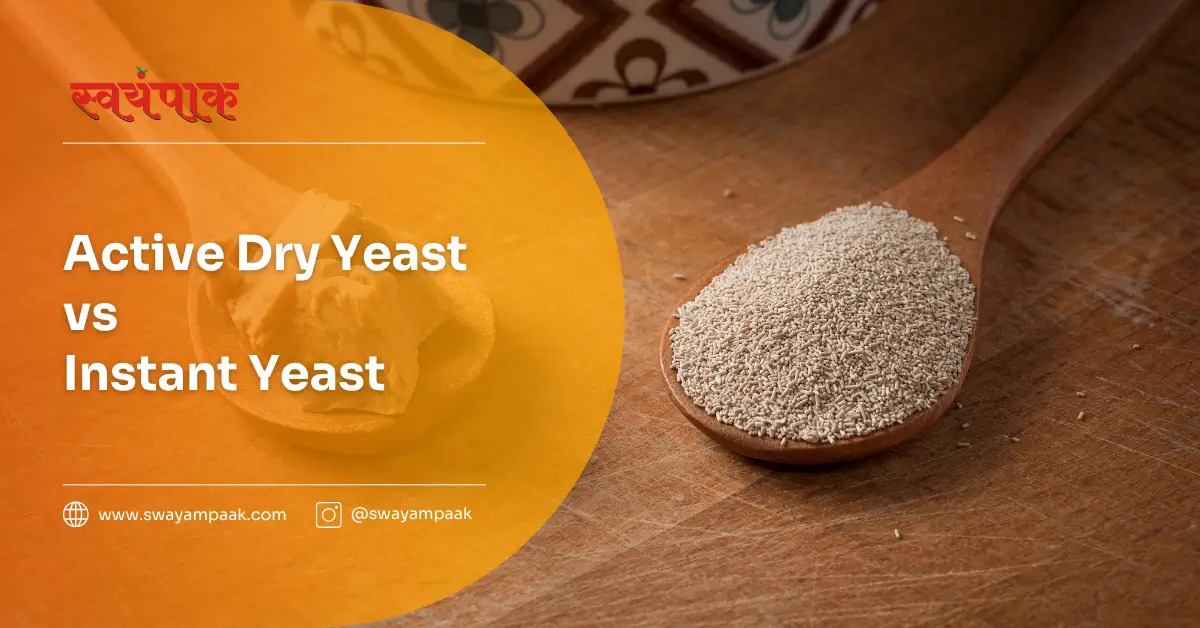Are you a baker? Even if you are not, you might have heard of this ingredient: YEAST. A product that bakers love to make their fluffy breads. Yeast as a fungal family includes the microscopic, single-celled organism known as yeast. In baking, yeast is essential for helping bread and other baked goods rise. It is made by combining flour, water, and sugar.
If you’re a home baker, you may be familiar with two types of yeast: active dry yeast and instant dry yeast. But have you ever wondered about the differences between these two? When should you use each one, and what are their advantages and disadvantages?
In this article, I will provide detailed information about active dry yeast vs instant yeast, including which one to use for your baking needs.
Basics: Active Dry Yeast vs Instant Yeast
What is yeast?
A fascinating single-celled creature, yeast scientifically known as Saccharomyces cerevisiae, is a member of the fungal kingdom. Despite being minuscule, it has a big impact on our lives, particularly in the food industry. Through a process known as fermentation, yeast breaks down carbohydrates into carbon dioxide and alcohol.
Yeast produces carbon dioxide gas during baking, which allows the dough to rise and gives bread and pastries their beloved airy quality. The intended result of winemaking and brewing is the alcohol that is produced. A very amazing creature, yeast is not only adaptable but also necessary for many industrial operations.
Different types of yeast
How many types of yeast do you know? There are many different types of yeast used in baking. Here we are discussing Active Dry Yeast vs Instant Yeast and their usage in baking and bakery industry.
Active dry yeast
- Before using rehydrate the dehydrated yeast in warm water.
- Its extended shelf life and ease of storing make it popular for baking at home.
- Frequently used to make bread and other baked products.
Instant Yeast
- Doesn’t need to be rehydrated.
- Direct addition to dry components is possible.
- It’s frequently used in bread machines and quick bread recipes, and it’s convenient for baking.
Compressed yeast (Less common in-home baking)
- Fresh, moist form of yeast sold in cakes or blocks.
- It requires refrigeration and has a shorter shelf life than dry yeast.
- Despite being less popular in-home baking, some bakers use it for its flavour and texture.
How yeast works: The fermentation process.
The single-celled creature known as yeast is essential to fermentation. yeast produces carbon dioxide and alcohol from carbohydrates through a process known as anaerobic respiration.
This procedure, which is frequently employed in baking and brewing, gives alcoholic beverages their distinctive flavours and raises the dough. Whether the end result is a glass of beer or a loaf of bread, it depends on the type of yeast and the conditions of fermentation.
Active Dry Yeast
Active dry yeast is a versatile ingredient frequently used in baking to raise the dough. It gives bread, rolls, and other baked goods a unique, airy texture and flavour. It is an affordable choice that keeps well in a cold, dry location for several months.
However, it does need to be rehydrated in warm water before use, which can take a little longer than instant yeast. It’s crucial to keep to the suggested water temperature for activation because it can be sensitive to extremely high or low temperatures. It might not rise as well if not enabled or stored appropriately.
Characteristics
- Appearance: small, beige-coloured particles.
- Storage: Keeps well in a dry, cool environment for an extended period.
- Activation: Before using, rehydrate in warm water.
- Rising Time: In general, it takes longer than instant yeast to rise.
Pros
- Long Shelf Life: It is convenient for home bakers because it can be kept for several months.
- Cost-effective: Frequently less expensive than other kinds of yeast
- Versatile: Suitable for a variety of recipes, including pizza dough and bread
Cons
- Requires Activation: Rehydrating is necessary prior to use, which may take a little longer than with quick yeast.
- The degree of temperature sensitivity: It’s crucial to adhere to the suggested water temperature for activation because they can be sensitive to extremely high or low temperatures.
- Potential for inconsistent results: It might not rise as efficiently if not properly engaged or stored.
Instant Yeast
Instant yeast is a dry yeast kind that dissolves rapidly in liquids because it is ground into extremely small granules. This removes the requirement for proving, which is the process of dissolving active dried yeast in warm water before adding it to the dough.
The dough rises as a result of the speedy activation of the yeast and the production of carbon dioxide gas by the fine granules of instant yeast, which absorb moisture from the dough.
Instant yeast is perfect for busy bakers who want to get their bread in the oven as soon as possible because of its speedy activation and rising time.
Characteristics
- Fine Granules: Instant yeast dissolves quickly in liquids because it has a far finer texture than active dry yeast.
- No Proofing Needed: Unlike active dry yeast, instant yeast does not require proofing before being added to the dry ingredients.
- Faster Rise Times: When used in warmer climates, instant yeast frequently produces faster rise times than active dry yeast.
Pros
- Convenience: Baking takes less time and work when proving is not required.
- Faster Results: In warmer climates, instant yeast can yield faster results.
- Longer Shelf Life: Compared to active dry yeast, instant yeast often has a longer shelf life, which makes storage easier.
- Versatility: Quick bread and rolls are among the many bread recipes that may be made with instant yeast.
Cons
- Temperature Sensitivity: Compared to active dry yeast, instant yeast may be more susceptible to changes in temperature. Temperatures that are too hot or too cold may impair its functionality.
- Less Flavour Development: Compared to active dry yeast, some bakers think that instant yeast might produce bread with a little less flavour development, particularly in doughs that rise more slowly.
When to use active dry yeast?
- Artisan bread: This yeast is ideal for artisan bread that needs a lengthy, gradual fermentation period; this enables the creation of chewy textures and rich flavours in the bread.
- Pizza dough: It is also used in making pizza dough; however, it usually takes longer to proof than instant yeast. If you want a faster rise, you may choose to use instant yeast or both.
- Buns and Rolls: It’s a fantastic option for fluffy, soft buns and rolls.
- Bagels: Bagels with a chewy texture and a hint of tang can be made with active dry yeast.
- Croissants: Although it’s not a common ingredient, some bakers use active dry yeast to give their croissants a distinctive flavour.
When to use instant yeast?
- Quick bread: Because it produces a flavourful crust and a speedy rise, instant yeast is perfect for quick breads like ciabatta and sourdough.
- Pizza dough: This yeast is perfect for midweek pizza dinners because it rises quickly and it produces a chewy interior and a crispy crust.
- Other baked products: It can be used to make croissants, bagels, and rolls, among other baked products.
Active dry yeast vs Instant yeast in pizza
To use active dry yeast in pizza, put it in a small bowl with warm water and a pinch of sugar. Give it 10 minutes or so to sit until it starts to foam, which means it’s active. Next, combine this mixture with your olive oil, salt, and flour.
Let the dough rise in a warm location until it doubles in size after kneading it until it is smooth. After it has risen, form it into the pizza crust of your choice and sprinkle your preferred toppings on top.
To use quick yeast for pizza, just combine it with warm water, flour, and salt. There’s no need to prove the yeast individually! After kneading the dough until it is smooth, let it rise in a warm location until it has doubled in size.
Once risen, punch down the dough, form it into the desired pizza crust, and then allow it to rise for a little period of time. Once the crust is golden brown and the cheese is bubbling, add your preferred sauce, cheese, and toppings and bake.
Pizza can be made using both kinds of yeast, but their active ingredients provide slightly different outcomes.
A richer flavour and a chewier crust are produced by active dry yeast. It is perfect for those who want to take their time and enjoy a slower, more conventional approach to making pizza.
While Quick-Rise Yeast will be slightly less chewable and have delicate flavours, it is a convenient option for those who want to make pizza in a shorter length of time.
Conclusion
In baking, knowing the essential distinction between instant and active dry yeast is essential to getting the results you want. Although both yeasts have the same function of raising the dough, they differ in certain ways that affect the finished result.
Slow-fermented breads and artisan loaves benefit greatly from the rich flavour development and extended shelf life of active dry yeast. Rehydrating is necessary, which adds a little more time, but the texture and flavour are satisfying.
Conversely, instant yeast provides speed and convenience. It is ideal for busy bakers and recipes that require speedy outcomes because of its quick activation and shorter rise periods. It might not, however, always provide the same level of flavour depth as active dry yeast.
The decision between active dry yeast and quick yeast ultimately comes down to your individual baking objectives, time limits, and preferred results. You may improve your baking efforts and make wise judgements by being aware of their advantages and disadvantages.


